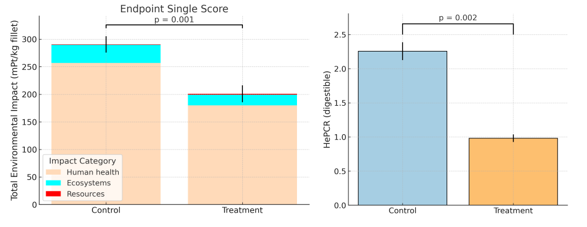REDUCING FEED-FOOD CONFLICT OF GRAIN-FED EUROPEAN FISHPONDS BY LOW-OPPORTUNITY-COST BIOMASS: PONDS, THE COW OF AQUACULTURE?
Introduction
Every year, the Central Eastern European region fishponds (0.25 million hectares, 0.12 million tons fish) consume ≥0.3 million tons of grains such as wheat, corn, triticale, rye, and barley, that could be otherwise fed directly to human food chain. Pond-fed grains may occupy approximately 46000 hectares of arable land that could be directly used for cultivating human food. Although European fishponds have low footprints, this grain-feeding still poses feed-food conflict in the current food system and require alternatives. In the present experiment (vegetative season 2024), our aim was to understand the limits of European fishponds by reducing 55% of wheat input and replacing it with a low-cost, non-refined and plant-based LOCB (low-opportunity-cost-biomass, i.e. local agri-food by-products or co-products) feed that was fed in harmony with the pond’s natural food web following the ‘balanced pond feeding concept’. Specific objectives were to evaluate: (1) production performance, (2) environmental impact assessment (both LCA and in-situ), and (3) human food systems impact of reducing feed-food conflict associated with European fishponds.
Materials and Methods
The LOCB pond feed that was fed to common carp (Cyprinus carpio) resembled more of a ruminant/ monogastric feed (than a fish feed) having low crude protein (22.7%, lysine 0.9%, methionine 0.47%) possibly with high anti-nutritional factors (ANF), low crude fat (3.78%), and high fiber (neutral detergent fiber, NDF= 21%; acid detergent fiber, ADF= 14%; starch 27.7%) contents with poor feed conversion ratio (FCR ~4), measured in laboratory. It was composed of 71% human-inedible, locally-sourced LOCBs (breakfast-cereals factory discards, rapeseed, sunflower expellers, and corn DDGS) and 29% human edible biomass (28% wheat + 1% rapeseed oil) with formula cost of ~0.32 EUR kg−1 near the cost of wheat (~0.20 EUR kg−1). The LOCB pellet was twin-screw extruded floating-type. Wheat (fed as grains; sinking) was more refined, low protein (9.5%, lysine 0.27%, methionine 0.16%) without a high ANF, high in starch (59.1%), and low in fibers (NDF 9.9%, ADF 4.4%) with lab FCR also ~4. A set of 9 experimental fishponds (each 0.16 ha area, 0.8 m depth each, stocking density 471 kg scaly common carp ha−1, initial body weight: 384 ± 81 g, 2+ years old) was assigned into two groups: “control” (triplicates) and “treatment” (six replicates). Treatment was nested (3+3) for optimizing LOCB feed utilization by fixed-time hand-feeding or all-day demand feeders. The isogenous stocked ponds received isogenous amounts of supplementary feed (3500 kg ha−1) with control ponds fed traditionally with wheat. Total dosage was sub-divided into fixed monthly feeding plan: April (3%), May (7%), June (11%), July (32%), August (25%), September (15%), and October (7%). The treatment ponds received wheat during beginning-of-season (April to June, 22% of total input) and LOCB-feed during end-of-season (July to October, 78%). Ponds were fed daily. Monthly sampling for fish growth, water quality, plankton, and sediment (bi-monthly) were done. Ponds were harvested in beginning of November, filleting yield and fillet nutrient composition was assessed. Life cycle impact assessment and nutrient (material) flow analysis for food system was carried out.
Results
All ponds had statistically similar (p>0.05) survivability, fish yield, final fish size, FCR, filleting yield, EPA+DHA or total amino acids irrespective of control or treatment. Results suggest commercial production is not hampered by replacing 55% of wheat input with LOCB. Treatment carp was significantly (p<0.05) less fatty than control carp, which is a positive takeaway for regional fish gastronomy sector.
All ponds had statistically similar (p>0.05) chlorophyll-a, zooplankton trends, and nutrient (C, N, P) concentrations in water or sediment. The organic C reserves in pond soil before harvest were maximum in treatment ponds. Results suggest LOCB feeding cannot be associated with causing nutrient pollution or eutrophication.
In terms of food web, from a lab-measured FCR of ~4 (bad), both wheat and LOCB-feed showed pond-measured FCR of ~2.7 (good). The contribution from pond’s natural food web to support carp yield was not altered (p>0.05) by replacing 55% of wheat input with LOCB. This is a win-win for fish farmers and water protection.
Total environmental impact was significantly lower (p<0.01) in treatment (200 mPt kg−1 fillet) than control (290 mPt kg−1 fillet). Impacts on human health and ecosystems are significantly lowered (p<0.01), except for resources consumption being significantly increased (p<0.05) due to capturing, mobilizing, and re-manufacturing LOCBs itself.
For the food system, the treatment became ‘net producers of protein’ with human edible protein conversion ratio (digestible), HePCRd of ≤1, significantly different (p<0.01) from control which was identified as net consumer of protein (HePCRd 2.2) due to input of human-edible wheat. Ponds are solely net-producers of n-3 LC-PUFA, as there is zero-input via wheat or LOCB-feed. The net n-3 LC-PUFA production is more sustainable (p<0.01) in treatment (500 mg kg−1 human-edible ingredient) than control (250 mg kg−1 human-edible ingredient). Results suggest a need for a reduction of feed-food conflict associated with grain-fed European fishponds, at least 55% as a starting point, by replacement with plant-based LOCBs.
Discussions
Integrating LOCB feeds would position European pond carp farming as the "cow of aquaculture and food systems” efficiently converting low-value biomass into nutritious food. Government subsidies should support such LOCB pond feed adoption, offsetting higher costs than grain-feeding to fulfill EU food system (i.e., low feed-food conflict, net producers of farmed nutrients) and nature restoration targets (i.e., higher recycling, regenerative farming). European fish-feed companies should seize the untapped market niche (≥0.3-million-ton year−1) for LOCB-based pond feeds, uniquely suited for regenerative pond systems. Although gaseous emissions were not measured, sediment organic C reserves improved with LOCB feeds. Overall, at semi-intensive carp production levels (≤0.5-ton ha−1 stocking, 1.2–1.4 tons ha−1 yield in 7 months), LOCB feeds strongly outperform grain-based alternatives in reducing feed-food competition.
Acknowledgment: The study was funded by NAZV QK22010177 and OP JAK CZ.02.01.01/00/23_021/0012616 (PI: Jan Mraz). Thanks to Giovanni M. Turchini for awarding the metaphor: “Ponds – the holy cow of aquaculture”.
